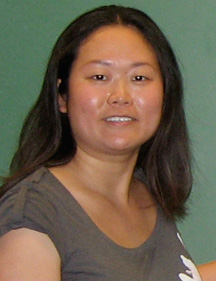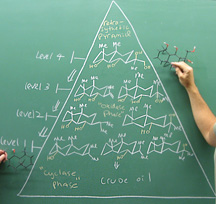

Scientists Devise New Strategy for Simplifying the Synthesis of Important Chemical Class
By Mark Schrope
Terpenes are a massive class of chemicals that includes numerous biological and commercial products, from vitamin A to the successful cancer drug TaxolTM. But, despite widespread use, chemists have remained frustrated in their attempts to synthesize terpenes in the laboratory at sufficient scale for commercial or, in many cases, even research purposes. But at last, a Scripps Research Institute team has devised a terpene production method that could prove widely applicable to even the most sought-after molecules, opening a range of new drug development and other possibilities.
The team, led by Scripps Research chemist Phil Baran, describes the new technique and its application in synthesizing five terpenes in an advance, online issue of the journal Nature published May 13, 2009.
Terpenes are a ubiquitous chemical class of hydrocarbons found in everything from pesticides to perfume to medicines, as well as throughout the body. Marco Polo's 13th century writings document medicinal use by the Chinese of the simple molecule camphor, which in 1903 would become the first terpene synthesized by chemists. The science of synthesis has undergone a gradual revolution since those early days and now terpenes of almost any complexity can be synthesized in the laboratory. However, when it comes to making large quantities of complex terpenes from scratch, there is much work that still needs to be done.
"There has been a fundamental disconnect between the efficiency with which nature makes terpenes and how we go about doing it," says Baran, who conducted the research with Ke Chen, a research associate in his lab. "When a target is above a certain level of complexity, organic chemists have simply not been capable of supplying sufficient material."
TaxolTM is one example of this problem. While there have been a number of syntheses published—including a breakthrough in 1994 by Baran's former Ph.D. advisor and current department chair K.C. Nicolaou of Scripps Research—each synthesis is complex and leads to only tiny quantities of product. Commercially, TaxolTM is still produced using plant extracts, in this case from an exotic yew tree. "In reality, terpene biosynthesis is light years ahead of what organic chemists can accomplish," says Baran.
Trying to Mimic Nature
In nature, terpene production typically involves two phases. The first is known as the cyclase phase and comprises various chemical additions and rearrangements driven by enzymes to produce specific hydrocarbon frameworks. Whereas chemists cannot precisely mimic this type of chemistry, the production of meaningful quantities of these hydrocarbon frameworks using modern methods is possible.
The snag comes in step two, the oxidative phase, where enzymes essentially blast those hydrocarbon frameworks with oxygen atoms to create a panoply of very active molecules. Chemists have not come close to mimicking this phase, instead having to settle for achieving the oxidation through wholly different and highly inefficient methods.
The Baran group, however, set out to challenge the long-held notion that only nature and enzymes can perform efficient oxidation in terpene building.
A conventional method for synthesizing a terpene would be to examine the final product and then look for a logical linear path of simpler and simpler compounds that in reverse will produce the target. This can lead to overly complex syntheses, in part because it often requires protecting groups—which must later be removed—that block unwanted bonding reactions as needed chemical groups are added.
The scientists modified this conventional method, known as retrosynthesis, to create a fundamentally different approach. In the current research the team applied the new approach to the syntheses of a group of biologically active terpenes called eudesmanes. They chose the group because, while complex, the molecules are several degrees simpler than molecules such as TaxolTM, making them a good starting point for the research.
Climbing the Pyramid
The first step involves the creation of what Baran calls a "retrosynthesis pyramid." This diagram places the highest oxidized target at the apex and works backward until the lowest oxidized members are reached. Rather than making strategic disconnections to a single molecule, multiple molecules are considered at every descending level of oxidation. Upon reaching the lowest oxidation level, a final target is chosen as the most logical starting material, for both its ease of synthesis and potential to access the greatest number of possible intermediates as one ascends the pyramid.
The synthesis of the most logical starting material is conceptually equivalent to the cyclase-phase in terpene biosynthesis. "The first phase was nothing more than a chess puzzle," says Baran. "It was creative reordering of known chemistry." In this work, the researchers were able to use inexpensive crude oil byproducts to generate gram quantities of the dihydrojuneol, one of the simplest members of the eudesmane family.
The primary challenge was ascending the pyramid (mimicking the oxidase-phase). At each individual level, multiple molecules termed "redox-isomers" are scrutinized for feasibility in the required oxidation to reach the next level. By doing so, the team was able to identify a path for each target that would not require any protecting groups, but instead depended on the creation of a new directing group—a chemical component that controls the strategic addition of specific oxygen atoms during the synthesis. This directing group was described in an earlier paper.
The team synthesized five different eudesmanes as general proof of its new approach. In principle, this strategy can be used to develop syntheses for any terpene.
"The next steps are to go on to higher levels of complexity and to invent more methods, reagents, and strategies to achieve the 'oxidase' phase without enzymatic intervention," Baran says.
The work for this research paper, titled "Total Synthesis of Eudesmane Terpenes by Site-Selective C-H Oxidations," was supported by funding from Bristol-Myers Squibb. For more information, see http://www.nature.com/nature/journal/vaop/ncurrent/abs/nature08043.html.
Send comments to: mikaono[at]scripps.edu

"There has been a fundamental disconnect between the efficiency
with which nature makes terpenes and how we go about doing it," says
Professor Phil Baran.

Research Associate Ke Chen is first author of the new Nature paper.

The team used what Baran calls a "retrosynthesis pyramid" to help attack
the problem of producing terpenes, a ubiquitous chemical class found in
everything from pesticides to perfume to medicines.
